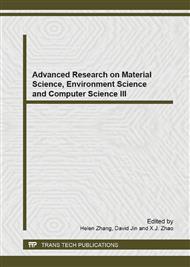[1]
Alam, M., and Zhou. Y. 2008. Strouhal numbers, forces and flow structures around two tandem cylinders of different diameters. Journal of Fluids and Structure, 24, 505-526.
DOI: 10.1016/j.jfluidstructs.2007.10.001
Google Scholar
[2]
Baranyi, L., 2004. Numerical simulation of flow past a cylinder in orbital motion. Journal of Computational and Applied Mechanics, 5, 209–222.
Google Scholar
[3]
Bearman, P. W., and Wadcock, A. J. 1973. The interaction between a pair of circular cylinder normal to a stream. Journal of Fluid Mechanics, 61, 499-511.
DOI: 10.1017/s0022112073000832
Google Scholar
[4]
Clift, R., Grace, J., Weber, M.E. 1978. Bubbles, Drops and Particles. New York: Academic Press.
Google Scholar
[5]
Dalton, C., Xu, Y., and Owen, J. C. 2001. The suppression of lift on a circular cylinder due to vortex shedding at moderate Reynolds numbers. Journal of Fluids and Structure, 15, 617-628.
DOI: 10.1006/jfls.2000.0361
Google Scholar
[6]
Igarashi, T. 1981. Characteristics of the flow around two circular cylinders arranged in tandem (1st report). Bulletin of the Japan Society of Mechanical Engineering, 24, 323–331.
DOI: 10.1299/jsme1958.24.323
Google Scholar
[7]
Igarashi, T. 1982. Characteristics of a flow around two circular cylinders of different diameters arranged in tandem. Bulletin of the Japan Society of Mechanical Engineering, 25, 349–357.
DOI: 10.1299/jsme1958.25.349
Google Scholar
[8]
Prasad, A. and Williamsion, C. H. K. 1997. A method for the reduction of bluff body drag. Journal of Wind Engineering and Industrial Aerodynamics, 69, 155-167.
DOI: 10.1016/s0167-6105(97)00151-7
Google Scholar
[9]
Sakamoto, H., Tan, K., Haniu, H. 1991. An optimum suppression of fluid forces by controlling a shear layer separated from a square prism. Journal of Fluids Engineering, 113, 183–192.
DOI: 10.1115/1.2909478
Google Scholar
[10]
Sumner, D., Price, S. J., and Paidoussis, M. P. 2000. Flow-pattern identification for two staggered circulation cylinders in cross-flow. Journal of Fluid Mechanics, 411, 263-303.
DOI: 10.1017/s0022112099008137
Google Scholar
[11]
Zdravkovich, M. M. 1977. Review of flow interference between two circular cylinders in various arrangements. ASME. Journal of Fluids Engineering, 99, 618-633.
DOI: 10.1115/1.3448871
Google Scholar
[12]
Zdravkovich, M. M. 1987. The effect of interference between circular cylinders in cross flow. Journal of Fluids and Structure, 1, 239-261.
Google Scholar
[13]
Zhao, M., Cheng. L., Teng, B., and Liang, D. F. 2005. Numerical simulation of viscous flow past two circular cylinders of different diameters. Applied Ocean Research, 27, 39-55.
DOI: 10.1016/j.apor.2004.10.002
Google Scholar
[14]
Zhao, M., Cheng, L., Teng, B., and Dong, G. 2007. Hydrodynamic forces on dual cylinders of different diameters in steady currents. Journal of Fluids and Structure, 23, 59-83.
DOI: 10.1016/j.jfluidstructs.2006.07.003
Google Scholar


